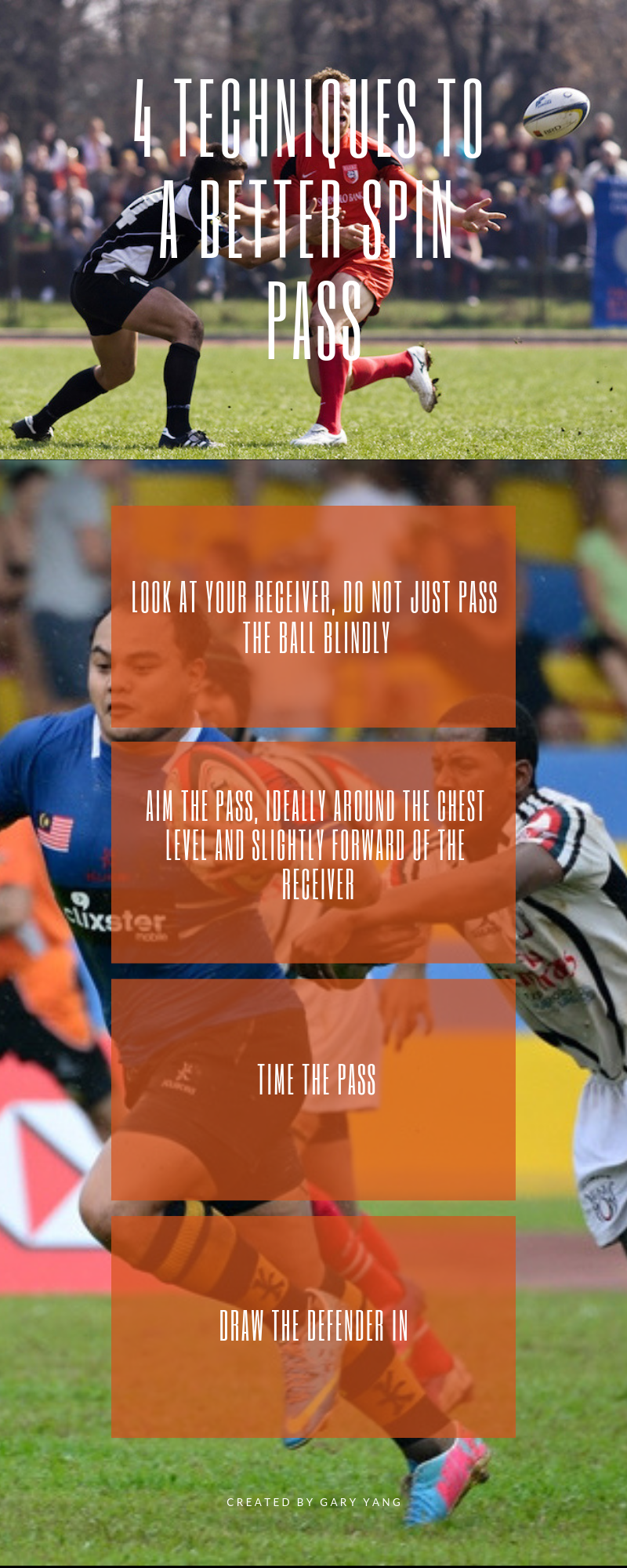Rugby: Types of passing & catching and how to improve them
Click here to get your tickets to the HSBC Singapore Rugby Sevens!
While they may all look the same, the different types of passes are all used in very different situations. Here are some of the few most commonly used passes, and how to effectively catch the ball thrown using these passes.
What is a Spin Pass and how to execute it?
Also known as the spiral pass, the spin pass is one of the most frequently used passes in any game of rugby due to its wide range of uses. The ball travels over a longer distance at a faster speed when in a spin pass compared to most other passes, but can be much harder to catch, as the ball will be spinning quickly. Backs tend to use it more than the forwards.
The spin pass is executed by a player holding the rugby ball with only his thumb on the one hand and fingers on the other. Next, the player should draw his arms back away from the direction of the teammate he is aiming the pass at, before throwing his arms across his body in that direction. This is so that there will be more force involved in the pass and thus allowing the rugby ball to travel over a longer distance. Following this, the player will let go of the ball by pulling his fingers up in a flicking motion to ensure that the ball spins. For maximum accuracy, throw the ball at chest height.
4 techniques to a better spin pass
- Look at your receiver, do not just pass the ball blindly
- Aim the pass, ideally around the chest level and slightly forward of the receiver
- Time the pass
- Draw the defender in, run towards the opposing defender before making the pass to create the “gap” for your teammate to breakthrough and gain more ground
 Credit: Gary Yang/ SportSG
Credit: Gary Yang/ SportSG
What is a Pop Pass and how to execute it?
Unlike the spin pass, the pop pass is most commonly used to get the ball to a nearby player over a short distance. This pass does not make the teammate a target but instead tries to aim the ball at the position where the teammate will be at to receive and catch the ball at full speed. Hold the ball vertically, with both hands at the lower half of the ball, and flick both your wrist at the same time to project the ball upwards. It is commonly used in a technique called the ‘switch’ where players decide to change the direction of play in the middle of the game.
When is the right time to execute a pop pass?
This type of passing can be used when you want to pass the rugby ball to a team mate in close support, and is extremely useful when a support player is running fast and close by to take advantages of a gap in the defence.
What is a Dive Pass and how to execute it?
Also known as a scrum-half pass, the dive pass is often used when the ball is on the ground and when it is near the base of the scrum or in a ruck between both teams. As its name suggests, this pass involves the player diving while attempting to move the ball to his teammate.
The player should bend at the waist to pick up the ball from the ground with both of his hands. Next, he should position himself towards the direction of his teammate, while keeping the ball below his body. Once he has angled himself properly, the player should dive in that direction while bringing his arms up to release the ball and pass it to his teammate.
When is the ideal situation for a dive pass?
It is good to use a dive pass when the ball is on the ground and a long clearing pass is required. Usually used when the team needs to clear the ball, passing it to a kicker further out to kick the ball forward.
Catching a rugby ball
As the saying goes, it takes two hands to clap, hence being able to catch a receiving pass is critical in rugby as well. While it sounds simple, there is a specific way for players to catch the balls, especially when the ball is being kicked. The player should attempt to catch the ball by raising both hands upwards towards the ball before it reaches him. In order to catch the ball safely, lock both elbows in front of the chest so that the player is able to secure the ball. As for catching a pass from a teammate, the guiding principle is to place your hands outstretched, bend your elbows slightly and palms facing out towards the direction of the ball. Also, it’s important to keep eye contact on the ball instead of looking at your onrushing opponent.
Tips on how to catch well
- Always have eyes on the ball
- Avoid distractions on the pitch
- Practice to have better hand-eye coordination (Click here for 4 easy drills to improve hand-eye coordination)
Muscles engaged when playing rugby
- Quadriceps, hamstrings, and the gluteals and the calf muscles; the gastrocnemius and soleus (Cycling actually allows you to work this group of muscles)
- Trapezius and neck muscles (The dumbbell shrug works this group of muscles. Click here to find out more)
- Rectus abdominus, obliques, and the spinal erectors (Sit-ups and crunches help work this group of muscles)
- Deltoids, latissimus dorsi, and the pectorals (Bench presses and push ups will do the trick for this group of muscles)
To receive the latest updates on the happenings in the Singapore sports scene, or to find out more about some of the latest programmes on offer at ActiveSG, like our Facebook page here.





![ActiveSG Academies and Clubs Logo (Solid Colour)[8647]](https://www.activesgcircle.gov.sg/hs-fs/hubfs/ActiveSG%20Circle%202023Theme/images/ActiveSG%20Academies%20and%20Clubs%20Logo%20(Solid%20Colour)%5B8647%5D.png?width=150&height=65&name=ActiveSG%20Academies%20and%20Clubs%20Logo%20(Solid%20Colour)%5B8647%5D.png)



-01.png?width=200&height=141&name=Team%20Singapore%20Logo%20(Red)-01.png)



